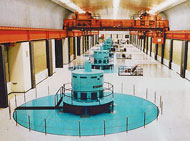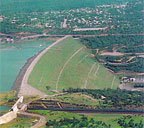| |
Dean Marachi began his higher-education shortly after graduating in the top 7 (of 310 students) of the 1960 class of Alborz High School, Tehran's
most prominent. One week after graduation he left Iran for the U.S.
In
1965, he earned his
B.S. in Civil Engineering from Oregon State University with tuition scholarship grants for much of his undergraduate degree. He took all of the geotechnical engineering
courses that were offered at OSU, as well as courses in geology.
He worked in the soil mechanics laboratory on a research
project for USSC to classify all soils in Oregon, and ran
complete sets of soil classification tests on nearly 50 different
soil types. He also worked on a research project for Professor Peterson
on the behavior of dis-similar materials, e.g. reinforced
wood, and developed a fundamental interest in learning interactive
behavior of two dis-similar materials, the effects of boundary
conditions, and what happens at the contact. This is a major
topic in science and technology, e.g. paint industry, reinforced
concrete, lined tunnels, concrete or steel pipelines through
earth dams, etc.
He attended UC Berkeley in September of 1965 and received
Masters of Science degree nine months later, continueing
his graduate studies and earning his Ph.D. in May of 1969—only 2 years and 8 months later. In this period
he took all courses offered in geotechnical engineering, including:
- Soil mechanics
- Foundation Engineering
- Earth dams
- Seepage and groundwater
- Physico-chemical properties of clays
- Theoretical soil mechanics
- Soil dynamics
- Pavement design
- Field investigations and laboratory testing
For his two minors, as required for the Doctorate degree,
he selected Geological Engineering and Physics of the Earth/Seismology.
For the geological engineering minor, he again took all courses that
were offered, including:
- Air photo interpretation
- Geological mapping and structural analysis
- Geophysical investigations
- Rock mechanics (theoretical, applied, and field and laboratory
testing)
- Soil and rock tunneling
- Rock block stability
For the seismology/physics of the earth minor, the courses
he took covered the following:
- Plate tectonics
- Mountain building/Isostasy
- Heat transfer/convection, conduction
- Physiography / geomorphology
- Wave propagation in solids, liquids, gases
- Faulting
- Seismicity
Additionally, he audited courses in structural dynamics,
computer methods/finite element method of analysis, and statistical
thermal physics.
To support himself and his family he worked as Research
Assistant during his graduate studies. Some of the research
work he undertook are as follows.
Research for Professor J. M. Duncan was mostly on properties
of unsaturated soils, suction pressure in unsaturated soils
and its effect on measured permeability, velocity of saturated
front as a function of water content. He also worked on the
effect of intermediate principal strain (not the stress) on
strength of sandy soils. Later he and Prof. Duncan published
this work as it had important practical implications in geotechnical
engineering.
 He also did research for Prof. R. E. Goodman, which included
development of a computer program for, and stability analysis of a 3-D model of rock
block and seepage pressures in the abutments of Malpasset
Dam to explain the mechanism of the 1960 failure causing loss
of 3,000 lives. He also performed a finite element analysis
of stresses in the roof of the underground excavation of the
Hyatt Power Plant at the Oroville Dam facility, then under
construction, to assess rock bolt requirements for the cavity. He also did research for Prof. R. E. Goodman, which included
development of a computer program for, and stability analysis of a 3-D model of rock
block and seepage pressures in the abutments of Malpasset
Dam to explain the mechanism of the 1960 failure causing loss
of 3,000 lives. He also performed a finite element analysis
of stresses in the roof of the underground excavation of the
Hyatt Power Plant at the Oroville Dam facility, then under
construction, to assess rock bolt requirements for the cavity.
 Dr. Marachi's doctoral research, then under the tutelage of the late
Professor H. Bolton Seed, involved a comprehensive study of
strength and deformation properties of rockfill material.
This research, estimated at $20M, was financed through grants
from California DWR, National Science Foundation, USBR and
a number of other agencies. It included design of highly elaborate
testing equipment, instrumentation, and laboratory testing
of actual and modeled rockfill material. Results of his pioneering
research have been used for confirmation of the design of
Oroville and Pyramid dams in California, El Infernilo dam
in Mexico, and Tarbella dam in Pakistan, which are all built
and working satisfactorily. It is also published and/or referred
to by most text books in geotechnical engineering as well
as the U.S. Bureau of Reclamation design manual for dams. Dr. Marachi's doctoral research, then under the tutelage of the late
Professor H. Bolton Seed, involved a comprehensive study of
strength and deformation properties of rockfill material.
This research, estimated at $20M, was financed through grants
from California DWR, National Science Foundation, USBR and
a number of other agencies. It included design of highly elaborate
testing equipment, instrumentation, and laboratory testing
of actual and modeled rockfill material. Results of his pioneering
research have been used for confirmation of the design of
Oroville and Pyramid dams in California, El Infernilo dam
in Mexico, and Tarbella dam in Pakistan, which are all built
and working satisfactorily. It is also published and/or referred
to by most text books in geotechnical engineering as well
as the U.S. Bureau of Reclamation design manual for dams.
 
| |


